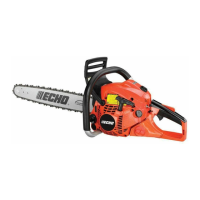CS-501P OPERATION
X7503312804 37
© 01/20 ECHO Incorporated
Felling The Tree
A falling tree can seriously damage anything it may hit - a car, a
house, a fence, a power line, or another tree. There are ways to
make a tree fall where you want it, so first decide where that is!
Before cutting, clear the area around
the tree. You will need good footing
while working and you should be able
to work the saw without hitting any
obstacles. Next, select a path of
retreat. When the tree begins to fall
you should retreat away from the
direction of fall at a 45-degree angle
and at least 3 m (10 feet) from the
trunk to avoid the trunk kicking back
over the stump.
Begin the cut on the side to
which the tree is to fall. Cut a
notch about 1/3 of the way into
the tree. The position of this
notch is important since the tree
will try to fall “into” the notch. The
felling cut is made on the side
opposite the notch and at a level
about 5 cm (2 in.) above the
bottom of the notch. Do not try to
cut through to the notch with the
felling cut. The remaining wood
between the notch cut and felling
cut about 5 cm (2 in.) will act as a hinge when the tree falls, guiding it in the
desired direction. When the tree starts to fall, kill the engine, place the saw
on the ground and make your retreat quickly.
Retreat
Retreat
Direction
45°
45°
3 m (10 feet)
Not this way
of fall
Direction of fall
First cut
Notch
Second cut
One-third tree diameter
5 cm (2 in.)
Felling cut
Hinge
5 cm (2 in.)

